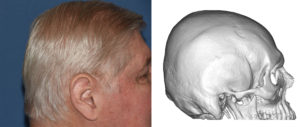Background: Flattening of the back of the head is one of the common aesthetic skull deformities. Many of these are mild and are likely caused by how one slept as an infant. But others are more severe and are caused by a genetic tendency based on ethnicity or familial tendencies or even from lambdoidal synostosis. These more severe flattening of the back of the head are known as brachycephaly and look like the back of the head has been cut off.
While brachycepahaly can be treated by cranial vault remodeling as an infant, the time available to do such bone-based surgery passes quickly. As an older child, teen or adult, such bone-based surgery is not an option. At these ages the concept becomes one of stretching out the overlying scalp by adding to the bone on top of it. While only bone cements have been used in the past to do so, they have numerous limitations and have been replaced by custom made implants based one the patient’s 3D CT scan. Such an approach offer a much better result (smoothness and contour) with a smaller incision length to do so.
A large skull implant augmentation and the amount of increased projection that can be achieved is ultimately determined by the amount of stretch that the scalp will permit. This will vary by a number of factors (scalp thickness, natural elasticity and incisional length access) but, as a general rule, the scalp can safely accommodate a 10 to 12mm immediate increase in central projection. (with a long side taper) Greater amounts of implant projection will require a first stage scalp expansion to accommodate it.




Highlights:
1) Severe flattening of the back of the head is known as brachycephaly.
2) For significant increased projection of the back of the head a first stage tissue expander is needed.
3) A second state custom skull implant can increase the projection of the back of the head by 25mm or an inch.
4) Age is not a limitation for skull augmentation surgery.
Dr. Barry Eppley
Indianapolis, Indiana


